Plant pests
 ©Janet Allen
©Janet Allen A difficult challenge
Edible gardens and groundhogs (aka woodchucks) just can't coexist.
They're such a problem they deserve their own page and a page for our solution.
 ©Janet Allen
©Janet Allen Hand-picking Japanese beetles the day before our first child was born!
As this photo shows we have been dealing with garden pests for many years, this photo being taken the day before our first child was born; she is now in her 30s.
We have some pests in our yard, but probably fewer than in many yards since we have many birds, dragonflies and other beneficial insects. We also have toads working the night shift.
Still, some cause problems, but generally not more than we can handle. If the problems are severe, we're more apt to discontinue growing vegetables that are particularly susceptible to a particular pest.
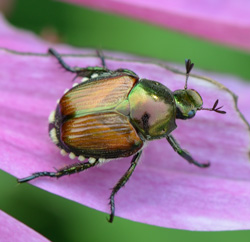 ©Janet Allen
©Janet Allen Japanese beetle
Sometimes, as for Japanese beetles, manually picking them off is a good solution. We also try to control cabbage worms by locating and removing their eggs and larvae.
Deer are a major problem for many gardeners. They were for us one year. One deer can consume quite a bit in one visit. The addition of three feet of deer netting to the top of our five foot fence in those area where the deer jumped the fence has worked well.
What we haven't done is use even "organic" pesticides, since even these can harm butterfly larvae and other beneficial insects.
Still, we have a very successful garden—and one that produces food we know is not covered with poisons.
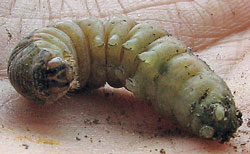 ©Janet Allen
©Janet Allen Unidentified larva of something.
We generally don't do anything until we know what something is. It could be the larval stage of one of our favorite butterflies, but I don't think so. Still we don't destroy first and ask questions later unless we see something actually damaging a plant. Even then, if it's the case of a black swallowtail caterpillar, for example, we just plant extra.
Cabbage worms
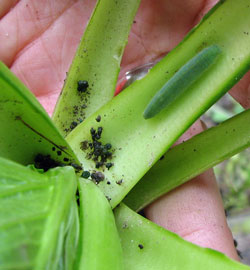 ©Janet Allen
©Janet Allen Cabbage worm
This is the cabbage worm and it can cause considerable damage over time to members of the cabbage family. It blends in perfectly, but the black specks are frass (his poop) that gives his location away.
Unfortunately, we didn't catch on to this soon enough, and they caused a lot of damage to our kale and collard crops in the summer of 2011.
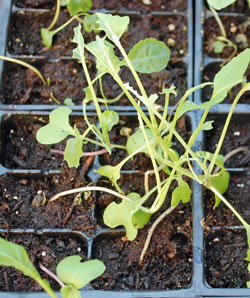 ©Janet Allen
©Janet Allen Cabbage worm damage
Seemingly overnight, the cabbage worms demolished our 6-packs of seedlings ready for planting.
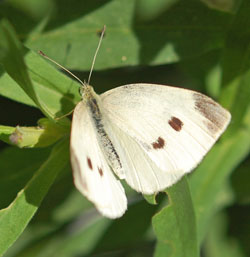 ©Janet Allen
©Janet Allen Cabbage white butterfly
This is the butterfly that lays the eggs that turn into the caterpillars that do all the damage.
This is a non-native butterfly, so we don't feel bad about our plans to eradicate it.
Slugs
 ©Janet Allen
©Janet Allen A slug
Slugs and snails are a big problem some years. Slugs mostly work at night so the best time to locate and remove them is early in the morning or, for a heavy infestation, in the evening with the assistance of a flashlight.
Slugs may be slow, but they're insatiable. They can do a lot of damage, and they seem to be a special problem in our coldframes.
We haven't been very successful with the beer remedy.
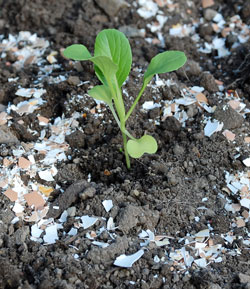 ©Janet Allen
©Janet Allen Eggshells as a deterrent
We put crushed eggshells in a ring around the little pak-choi plants to deter slugs. They supposedly don't like crawling over sharp objects like the edges of the eggshells. It seems to work.
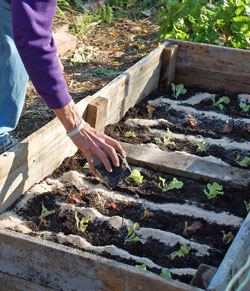 ©Janet Allen
©Janet Allen Bran as a deterrent and board
Here we're experimenting with putting bran between plants to deter slugs. They supposedly eat the bran and die. It didn't seem to have any effect.
Another method is placing a board, especially one with black plastic stapled to the bottom side, in the coldframe. Slugs tend to gather under it during the day, then we pick them off and drop them into soapy water.
Rabbits
 ©Janet Allen
©Janet Allen A charming litle bunny
This charming little bunny is eating our beets! It's definitely more adorable than the woodchuck, but still is a problem, though it's the first one (2012) we've seen in years.
We're hoping rabbit fencing will keep him out. We're optimistic since this had worked before. We had just taken the fencing down last year because we hadn't had any rabbits.
Squirrels
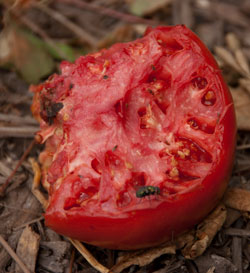 ©Janet Allen
©Janet Allen A tomato partly eaten by a squirrel
Before our pear and apple trees went into decline, the squirrels spent their time gathering pears. But when pears or apples weren't available, they've taken to getting our tomatoes. These huge tomatoes would theoretically feed many squirrels, but they tend to eat a little, then drop it. Why bother finishing it? There's so much more where that came from!
So now squirrels are one of our pests. In fact, we've also noticed that they're taking more than their fair share of the berries I've planted for birds, such as pagoda dogwood. More than a pest, they're actually a population out of balance.
Squash vine borers
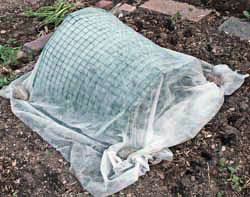 ©Janet Allen
©Janet Allen Squash protected by row cover
One year the squash vine borers outsmarted me, and its success was the end of our squash crop. I had started squash indoors and then transplanted them into the garden covered with row cover material to protect the plants from the wasp-like insect that lays the eggs of the borer. Assuming that was all I needed to do, I waited until the plants began to flower and then uncovered them. This is necessary for the flowers to be pollinated and form fruit. But the insects were still around and laid their eggs on the squash. Soon the borers were destroying the squash plants.
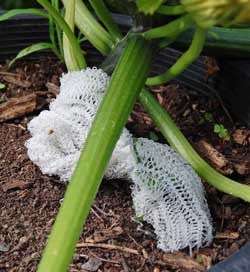 ©Janet Allen
©Janet Allen Cheesecloth around squash stem
The next year, I planted five patty pan squash plants. I put two in containers and three in the garden in various places. I also started a couple more later to use as fill-ins.
What I did for borers was to wind a narrow strip of cheesecloth around the base of the plant in the hope that it would prevent the insect from getting to the base of the plant to lay eggs. I also covered two of them with row cover material.
It seemed to work, but just as I was about to report that my plan was successful, parts of the plants began to wilt and fairly soon they were simply not producing very much. When I looked I could see that borers had dug their usual tunnels in the stem. But I must have delayed them for a while, with the result that we had over a hundred pounds of patty pan squash.
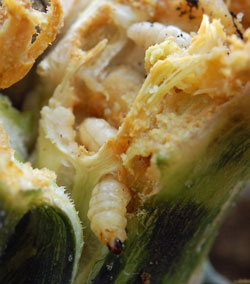 ©Janet Allen Squash vine borer
©Janet Allen Squash vine borerWhen do the borers arrive? I was surprised that my one "back-up" plant that I planted later also succumbed. I thought that the eggs for the borer are laid over a limited span of time and that a later planting would be after that time. My note for next year is to begin looking for the borer around June 20th.
Maybe the combination of covering, using cheesecloth, and inspections beginning June 20th will result in a season long crop of squash. Two or three plants should be enough.
We have learned that you can cut the stem of the plants pretty severely, try to squash the borers, and put the stem back together, cover it with soil, and the plants survive. The problem is to get all the borers. We counted 9 in one plant that was dissected.
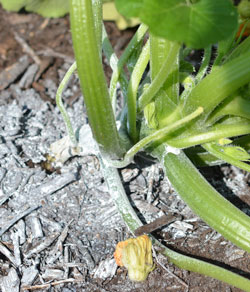 ©Janet Allen
©Janet Allen Kaolin clay
Our latest experiments have been with kaolin clay. The kaolin clay alone (2013) was not successful—that is, the plants were eventually destroyed by borers and the harvest of 36 pounds was less than in the previous three years.
In 2014 we combined cheesecloth with kaolin clay. Shortly after the two squash seedlings (which had been started indoors) were established, we removed the first pair of leaves, tied cheesecloth around the stem from the soil surface to the next leaves, and then sprayed the cheesecloth with kaolin clay.
The cheesecloth covered area was sprayed again a week or ten days later. The harvest from the two plants was 85 pounds! Admittedly, because there were often squash waiting in the refrigerator we did not always pick the squash in a timely manner, some were larger than we would normally have used. We eventually removed the plants because they were blocking the adjacent pathway. There was no damage from squash vine borers.
A fellow gardener reported a bumper crop of squash and had done nothing about squash vine borers, so it will take another year or two of this method before we can say it definitely works.
Cucumber beetles
The cucumber beetle is a sucking insect. Although it's called a cucumber beetle, it also attack other cucurbits, such as this squash it's investigating.
Flea beetles
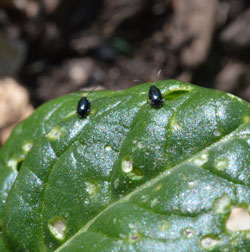 ©Janet Allen
©Janet AllenSome flea beetles
We try to control flea beetles by protecting small plants with row cover material. It is hard to exclude the flea beetles, however, as they are already in the soil.
They're especially a problem on our eggplants and Chinese cabbage.
Brown marmorated stinkbug
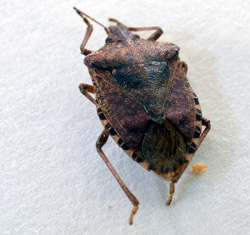 ©Janet Allen
©Janet Allen The top of the insect
We have seen the brown marmorated stinkbug in our yard and even in our house.
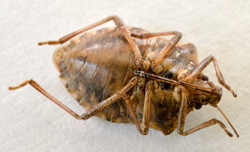 ©Janet Allen
©Janet Allen The bottom, a key way to distinguish between this and the native stinkbug
So far, we haven't noticed damage to our crops, but the BMSB is known as a huge agricultural threat to crops in Pennsylvania.
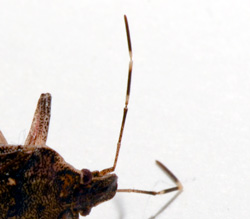 ©Janet Allen
©Janet Allen Another key point: the banded antennae
If this insect becomes more common, it could not only be a problem for our garden, but for all our farmers.

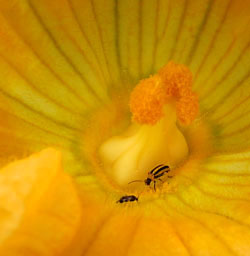 (Enlarge)
(Enlarge)